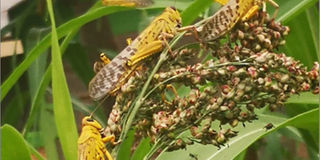Alarm as locusts adapt to evade spraying, change behaviour

Desert locusts that had invaded sorghum farms at Kiambere, Embu County. PHOTO | FILE | NATION MEDIA GROUP
What you need to know:
- Scientists warn that new breed has made it more difficult to spot them or predict their habits, which they change as a survival strategy.
Locusts have become more adept at beating measures meant to eliminate them, scientists have warned.
A new breed of insects has developed adaptations such as hiding under leaves and change of behaviour such as dispersing, making it hard for aerial spraying to kill them as the country battles to contain the invasion believed to be the worst in 27 years.
Collecting accurate data on the swarms has also become more difficult as their migration patterns and clustering has changed.
Samburu County Special Programmes Chief Officer Daniel Lesaigor said this has dealt a big blow to efforts to contain them.
“Aerial spray teams endure difficulties in trying to locate them. But we have learnt that they often hide beneath stalks and leaves,” Mr Lesaigor said.
Mr Lesaigor noted that the first swarms were easier to predict, compared to the new breed: “It’s not easy to spot them using aerial surveillance.”
The Food and Agriculture Organization (FAO) of the United Nations says when desert locusts increase in number and become more crowded, they change their behaviour from that of acting as an individual (solitarious) insect to that as acting as part of a group (gregarious).
This means that the locusts may have changed their behaviour as a survival tactic.
Officials note that the dry conditions that are being experienced in arid and semi-arid counties could prompt the pests to change and try to adapt.
“For now, we suspect that hot and sunny conditions are forcing them to hide under green matter,” Mr Lesaigor said.
The FAO also states that the appearance of the locust also changes as a result of the increase in numbers.
When the environment is favourable, often after heavy rains and cyclones, the locusts converge and change colour to pink (immature) and then yellow (mature) and form swarms.
Desert locusts, unlike many grasshoppers, can travel over long distances and change habits and behaviour.
It’s estimated that more than 30,000 people have been affected and more than 85,000 acres (34,400ha) of vegetation cover and pasture risk being destroyed by the locusts.
FAO notes that desert locusts can travel up to 150km in a day and eat their own body weight in greenery, meaning a swarm covering just one square kilometre can eat as much food as 35,000 people in a day.
Several swarms of the voracious pests, Mr Lesaigor said, have migrated from Samburu to the neighbouring counties of Marsabit and Baringo.





